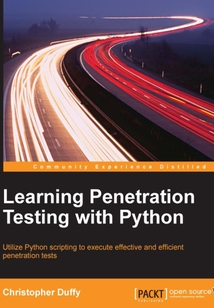目錄(95章)
倒序
- coverpage
- Learning Penetration Testing with Python
- Credits
- Disclaimer
- About the Author
- Acknowlegements
- About the Reviewers
- www.PacktPub.com
- Support files eBooks discount offers and more
- Preface
- What this book covers
- What you need for this book
- Who this book is for
- Conventions
- Reader feedback
- Customer support
- Chapter 1. Understanding the Penetration Testing Methodology
- An overview of penetration testing
- Understanding what penetration testing is not
- Assessment methodologies
- The penetration testing execution standard
- Penetration testing tools
- Summary
- Chapter 2. The Basics of Python Scripting
- Understanding the difference between interpreted and compiled languages
- Python – the good and the bad
- A Python interactive interpreter versus a script
- Environmental variables and PATH
- Understanding dynamically typed languages
- The first Python script
- Developing scripts and identifying errors
- Python formatting
- Python variables
- Operators
- Compound statements
- Functions
- The Python style guide
- Arguments and options
- Your first assessor script
- Summary
- Chapter 3. Identifying Targets with Nmap Scapy and Python
- Understanding how systems communicate
- Understanding Nmap
- Nmap libraries for Python
- The Scapy library for Python
- Summary
- Chapter 4. Executing Credential Attacks with Python
- The types of credential attacks
- Identifying the target
- Creating targeted usernames
- Testing for users using SMTP VRFY
- Summary
- Chapter 5. Exploiting Services with Python
- Understanding the new age of service exploitation
- Understanding the chaining of exploits
- Automating the exploit train with Python
- Summary
- Chapter 6. Assessing Web Applications with Python
- Identifying live applications versus open ports
- Identifying hidden files and directories with Python
- Credential attacks with Burp Suite
- Using twill to walk through the source
- Understanding when to use Python for web assessments
- Summary
- Chapter 7. Cracking the Perimeter with Python
- Understanding today's perimeter
- Understanding the link between accounts and services
- Cracking inboxes with Burp Suite
- Identifying the attack path
- Gaining access through websites
- Summary
- Chapter 8. Exploit Development with Python Metasploit and Immunity
- Getting started with registers
- Understanding the Windows memory structure
- Understanding memory addresses and endianness
- Understanding the manipulation of the stack
- Understanding immunity
- Understanding basic buffer overflow
- Writing a basic buffer overflow exploit
- Understanding stack adjustments
- Understanding the purpose of local exploits
- Understanding other exploit scripts
- Reversing Metasploit modules
- Understanding protection mechanisms
- Summary
- Chapter 9. Automating Reports and Tasks with Python
- Understanding how to parse XML files for reports
- Understanding how to create a Python class
- Summary
- Chapter 10. Adding Permanency to Python Tools
- Understanding logging within Python
- Understanding the difference between multithreading and multiprocessing
- Building industry-standard tools
- Summary
- Index 更新時間:2021-07-09 21:53:15
推薦閱讀
- Flask Blueprints
- Angular UI Development with PrimeNG
- Vue.js 3.x從入門到精通(視頻教學版)
- AIRAndroid應用開發實戰
- Programming ArcGIS 10.1 with Python Cookbook
- STM32F0實戰:基于HAL庫開發
- R Deep Learning Cookbook
- Learning Laravel's Eloquent
- Hands-On JavaScript for Python Developers
- Python從入門到精通(第3版)
- Learning Grunt
- SQL Server 2012 數據庫應用教程(第3版)
- Java程序設計入門(第2版)
- SAP HANA Cookbook
- 快速搞定Spring Boot+Vue全棧開發
- 大學計算機基礎教程
- Java多線程編程核心技術
- Mastering Application Development with Force.com
- Code-First Development with Entity Framework
- OpenCV計算機視覺編程攻略(第3版)
- C#程序設計任務式教程
- JavaScript DOM編程藝術(第2版)
- JSP網絡程序設計與案例開發教程
- Home Automation with Intel Galileo
- Spring微服務架構設計(第2版)
- Java程序員面試筆試寶典
- Mastering Windows Server 2016
- Unity 2020 Virtual Reality Projects
- C語言程序設計基礎教程
- C語言程序設計教程


